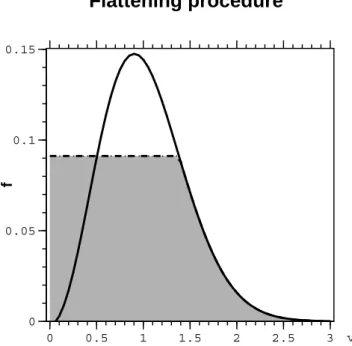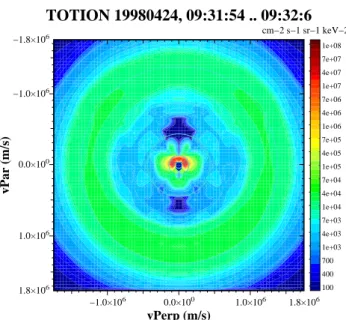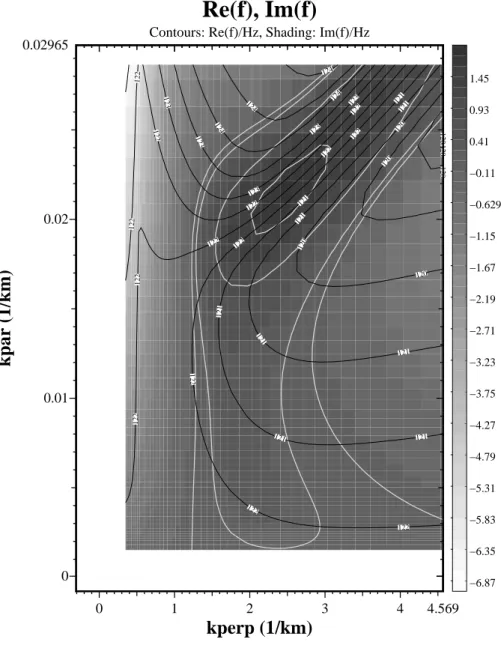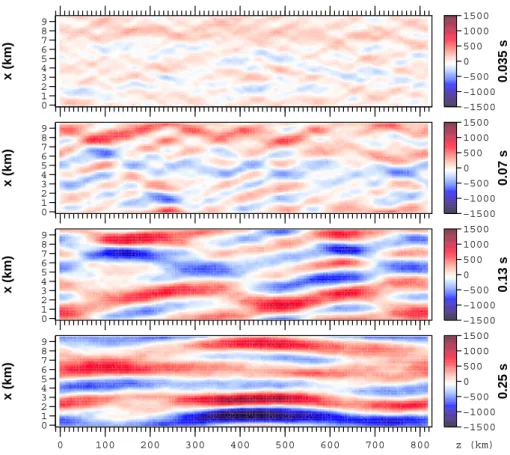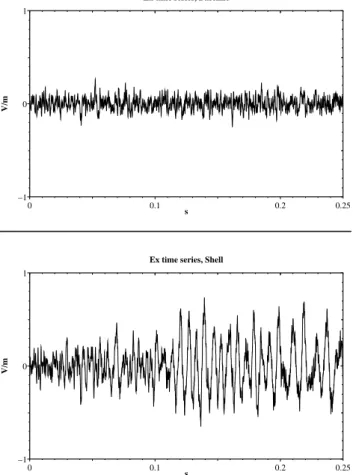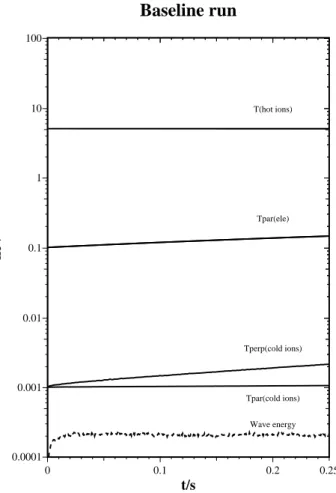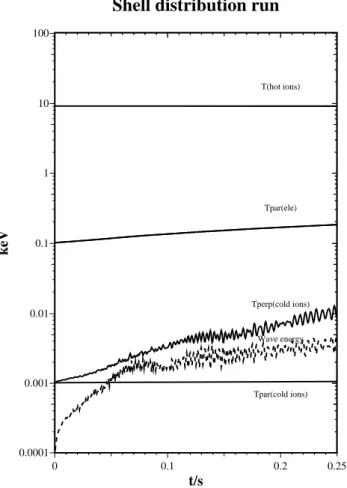HAL Id: hal-00317040
https://hal.archives-ouvertes.fr/hal-00317040
Submitted on 1 Jan 2003
HAL is a multi-disciplinary open access
archive for the deposit and dissemination of
sci-entific research documents, whether they are
pub-lished or not. The documents may come from
teaching and research institutions in France or
abroad, or from public or private research centers.
L’archive ouverte pluridisciplinaire HAL, est
destinée au dépôt et à la diffusion de documents
scientifiques de niveau recherche, publiés ou non,
émanant des établissements d’enseignement et de
recherche français ou étrangers, des laboratoires
publics ou privés.
Generation of Bernstein waves by ion shell distributions
in the auroral region
P. Janhunen, A. Olsson, A. Vaivads, W. K. Peterson
To cite this version:
P. Janhunen, A. Olsson, A. Vaivads, W. K. Peterson. Generation of Bernstein waves by ion shell
distributions in the auroral region. Annales Geophysicae, European Geosciences Union, 2003, 21 (4),
pp.881-891. �hal-00317040�
Geophysicae
Generation of Bernstein waves by ion shell distributions in the
auroral region
P. Janhunen1, A. Olsson2, A. Vaivads2, and W. K. Peterson3
1Finnish Meteorological Institute, Geophysical Research, Helsinki, Finland 2Swedish Institute of Space Physics, Uppsala Division, Uppsala, Sweden 3LASP, University of Colorado, Boulder, Colorado, USA
Received: 14 March 2002 – Revised: 12 September 2002 – Accepted: 15 October 2002
Abstract. Hot ion shell distributions could possibly con-tain enough free energy for waves that could power electron energisation above auroral inverted-V regions. Using both linear theory (WHAMP) and two-dimensional electrostatic simulations, we show that ion shell distributions can cause unstable ion Bernstein mode emissions with high temporal growth rates, as well as perpendicular and parallel e-folding distances, that are in accordance with the tranverse dimen-sions of auroral arcs and the parallel size of the energisation region, respectively. The phase velocities of the waves are in the proper range to give parallel energisation to electrons with a Landau resonance. The simulation shows that about 90% of the energy goes into electrons and 10% goes into cold ion perpendicular heating. An electron heating rate of ∼ 80 eV/s is obtained.
Key words. Ionosphere (auroral phenomena) – Space plasma physics (numerical simulation studies; wave-particle interactions)
1 Introduction
The most widely accepted model for the acceleration of elec-trons to form the inverted-V spectra above stable auroral arcs is the potential drop acceleration model (Carlqvist and Bostr¨om, 1970; Evans, 1974). However, it has also been sug-gested that instead of a static potential drop, plasma waves could be responsible for electron energisation. Lower-hybrid waves (Bingham et al., 1988; Bryant et al., 1991; Bryant and Perry, 1995; Bryant, 1999), as well as Alfv´en waves (Go-ertz and Boswell, 1979; Kletzing, 1994; Genot et al., 2000; Stasiewicz et al., 2000), have been suggested for this pur-pose. It has been pointed out by Louarn et al. (1994); Vol-werk et al. (1996); Wygant et al. (2000) that Alfv´en waves contain enough downward Poynting flux to power the aurora in at least some events during disturbed conditions. It was later suggested (Janhunen and Olsson, 2000) that both wave-Correspondence to: A. Olsson (ao@irfu.se)
particle interactions and a potential structure can accelerate electrons in cooperation. In this model the waves need to energise electrons in the parallel direction only to some hun-dreds of eV energy, since the potential structure takes care of producing a several keV inverted-V spectrum at low altitude. In this paper we suggest that ion Bernstein waves could be responsible for such wave-induced electron energisation. We approach the question by first identifying an energy source that contains enough free energy (the ion shell distribution) and then consider what wave modes the energy source can make unstable by applying linear analysis and particle simu-lation. Particle and wave observations from Polar are used to constrain the model.
2 Shell distributions
Ionic free energy sources, such as temperature anisotropies (T⊥ > Tk) and drifts and loss cones, have previously been considered to excite ion waves near the ion cyclotron fre-quency (Andr´e, 1986; Andr´e et al., 1986). However, consid-ering the energy needed to power the inverted-V electron ac-celeration in an auroral arc (typically a few tens of milliwatts per square meter when projected to ionospheric altitude, or clearly more than that in bright auroras), these free energy sources do not appear to be sufficient. As a possible rem-edy to this problem we consider a shell distribution, i.e. an isotropic (quasi-Maxwellian) hot ion distribution from which the low-energy core has been partly removed. Theoretical treatment of shell distribution has been given by Sentman et al. (1986) and Freund and Wu (1988). A shell distribu-tion could be generated, for example, by some process near the equatorial plane that energises hot ions in the parallel di-rection so that a positive slope in the distribution function in the parallel direction is generated (Elphic and Gary, 1990). Due to the conservation of energy and the first adiabatic in-variant, such a distribution turns into a shell-like distribution upon reaching lower altitudes. This has been shown for the
882 P. Janhunen et al.: Bernstein waves from ion shell distribution 0 0.5 1 1.5 2 2.5 3 v 0 0.05 0.1 0.15 f
Flattening procedure
Fig. 1. Example shell distribution generated by the expression
f (v) = exp(−v2) −1.00206 exp(−1.5v2). The velocity and the
distribution function are in arbitrary units. The shaded region de-limited by dotted line is the closest equilibrium distribution defined in the text. The free energy is 6.9% of the total kinetic energy in this case.
electrons by Barbosa (1977), but the same argument holds for ions as well.
We define the free energy of a given distribution function to be the kinetic energy of the original distribution minus the kinetic energy of the “closest” equilibrium distribution (the distribution which would be produced from the original dis-tribution by wave-particle interactions). Since positive slopes in velocity space are sources of plasma instabilities, we as-sume here that the wave-particle interactions locally “level out” the distribution in places where it has a positive slope, repeat the flattening procedure until no positive slopes are found, and assume that the resulting distribution corresponds to the closest equilibrium distribution.
Figure 1 shows an example of a shell distribution and its closest equilibrium distribution (shaded region delimited by dashed line) found by the flattening procedure. In this case the free energy is 6.9% of the total kinetic energy. This kind of shell distribution was constructed from a difference of two Maxwellians. If the shell distribution is constructed by other means, for example, by simply cutting away the centre of a Maxwellian, much higher free energies (25% and more) can be reached.
This definition of the free energy is only an upper limit of the physically available free energy. Our numerical simula-tions indicate that the way of estimating the free energy as defined above is adequate at least to obtain a starting point for numerical investigations. Thus, a shell distribution may contain much more free energy than, for example, an ion loss
cone distribution with a 5◦to 10◦loss cone.
To discuss the powering of auroral arcs we need to esti-mate the energy flux. Let us suppose that the process of ex-tracting the free energy from the shell distribution takes place at some altitude and that the shell distribution is continuously replenished by downgoing new particles at that altitude. The maximum possible downward energy flux is then vu, where vis the velocity of the ions forming the shell and u is the free energy density of the shell distribution. (This maximum en-ergy flux is not reached in the example given below in Fig. 3 because there the upgoing part still has free energy left, but the point here is to make a rough estimation only.) For ex-ample, if u = 0.5 keV cm−3(as it is in the example below, Fig. 2) and v ∼ 1.4 · 106m s−1(i.e. a shell consisting of 10 keV protons), we obtain an energy flux of 13 mW m−2when projected down to the ionosphere from 5 RE radial distance. Although this is an upper limit of the possible energy flux, it shows that there is potentially enough free energy in the shell distribution to power typical auroral arcs.
In addition to the spherical shell distribution considered in this paper, waves that become unstable by a ring (i.e. toroidal) ion distribution have been considered in the cusp by several authors (e.g. Huddleston et al., 2000; Roth and Hudson, 1985).
A shell distribution with a loss cone has been considered earlier and found to produce unstable lower hybrid waves (Bingham et al., 1999). The shell distribution with a loss cone was called the “horseshoe distribution” by Bingham et al. (1999).
3 Observations
In Fig. 2 we show an example of an ion shell distribution event in the auroral region at about 21 000 km altitude using Polar. We use data from the electric field instrument (Har-vey et al., 1995), TIMAS ion detector (Shelley et al., 1995) and HYDRA electron instrument (Scudder et al., 1995). The free energy enhancement in the ion distribution at 09:31– 09:34 UT (panel j) occurs close to electrostatic waves (panels b–d), simultaneously with an upward ion conic (panel g) and close to electron middle-energy Tk T⊥ type anisotropy (panels h and i). Panel (h) is the ratio of the parallel versus perpendicular electron distribution function (i.e. anisotropy) colour-coded so that red means that there are more parallel than perpendicular electrons in the given energy, whereas panel (i) quantifies the electron middle-energy anisotropy in density units by showing the parallel minus perpendicu-lar distribution function integrated in the region of velocity space corresponding to energies between 100 eV and 1 keV by a red line and similarly the up minus the down difference by a green line. Figure 3 shows the detailed ion tion function at 09:32 UT, clearly showing a shell distribu-tion. In this example the positive slope of the shell distri-bution is at ∼6 keV. Simultaneously with the high energy shell, some low energy (< 1 keV) ions also occur. A de-composition into H+ and O+ reveals that the shell is purely
−40 −30 −20 −10 0 V S/C Pot 0 5 0 1 2 3 kV mV/m 0.1 1 10 Eperp,Hz (mV/m)/Hz^0.5 0.01 0.1 1 10 0.1 1 10 Epar,Hz (mV/m)/Hz^0.5 0.01 0.1 1 10 0.1 1 10 0..30 totion 1/(cm2 s sr keV2) 100 103 104 105 106 107 108 0.1 1 10 75..105 totion 1/(cm2 s sr keV2) 100 103 104 105 106 107 108 0.1 1 10 150..180 totion 1/(cm2 s sr keV2) 100 103 104 105 106 107 108 0.1 1 10 ele Par/Perp 0.01 0.1 1 10 100 0 0.05 0.1 0.15 cm−3 100−1000 eV 09:10 09:20 09:30 09:40 09:50 UT 0 0.1 0.2 0.3 0.4 keV cm−3 TIMAS 21.96 22.09 22.2 22.32 22.44 MLT 11.52 9.5 7.831 6.454 5.321 L−SHELL 72.86 71.07 69.06 66.82 64.31 ILAT 4.824 4.588 4.342 4.089 3.827 R
19980424
a
b
c
d
e
f
g
h
i
j
Fig. 2. Polar data for 24 April 1998, 09:05–09:55 UT. Panels are named (a)–(j) from top to bottom. (a) Spacecraft potential from the
electric field instrument (EFI), (b) EFI Perpendicular electric wave amplitude in frequency range 1–10 Hz as 12-s average (green), parallel wave amplitude (red), plasma potential integrated along satellite trajectory (black), (c) perpendicular wave electric field spectrogram, (d) parallel wave electric field spectrogram, (e) total ion distribution function from TIMAS for 0–30◦pitch angle electrons (downgoing), (f) same for perpendicular ions (75–105◦), (g) same for antiparallel (upgoing) ions, 150–180◦, (h) ratio of parallel to perpendicular electron distribution function from HYDRA, (i) red line: parallel minus perpendicular electron distribution function integrated between 0.1 and 1 keV (the anisotropic density), green line: up minus down parallel component, positive means upgoing electrons, (j) free energy density in TIMAS ion distribution function.
884 P. Janhunen et al.: Bernstein waves from ion shell distribution −1.0×106 0.0×100 1.0×106 1.8×106 −1.8×106 −1.0×106 0.0×100 1.0×106 1.8×106
TOTION 19980424, 09:31:54 .. 09:32:6
vPerp (m/s) vPar (m/s) cm−2 s−1 sr−1 keV−2 100 400 700 1e+03 4e+03 7e+03 1e+04 4e+04 7e+04 1e+05 4e+05 7e+05 1e+06 4e+06 7e+06 1e+07 4e+07 7e+07 1e+08Fig. 3. Total ion distribution function from TIMAS at 09:32 during
the event shown in Fig. 2. A clear shell distribution is seen starting from 0.8 × 106m/s (3.5 keV). The blue circles correspond to en-ergies 10 eV (0.044 × 106m/s), 100 eV (0.14 × 106m/s), 1 keV (0.44 × 106m/s) and 10 keV (1.4 × 106m/s).
hydrogen, while the low energy ions are mostly oxygen (plot not shown). Thus, the shell is probably of magnetospheric origin and the low energy ions come from the ionosphere (an upward oxygen conic).
The wave electric fields at around 09:33–09:36 UT are mainly perpendicular, bursty and broad band (Fig. 2, panels c–d). Such electric fields have been named broad-band elec-trostatic noise (BEN) and they have been observed on auroral field lines in correlation with the occurrence of inverted-V events (Gurnett and Frank, 1977; Gurnett, 1991). The phys-ical interpretation of BEN is still not certain, but it has been suggested that ion Bernstein modes could be partly involved in the BEN spectrum (Ashour-Abdalla and Thorne, 1978). Afterwards, it has been shown by Andr´e (1986), with more extensive WHAMP computations, that ion Bernstein modes can be excited from a hot ion loss cone distribution, even in the presence of some cold plasma.
The electron anisotropies (panels h and i) are correlated with waves (panels c and d) but, over a short time at least, almost anticorrelated with the shell distribution free energy (panel j). Inspection of the ion distribution function shows that when the anisotropies appear at 09:34 UT, the H+ dis-tribution function has a plateau at the same energy where a shell distribution existed one minute earlier in the data (Fig. 4). Thus, it is possible that the middle-energy elec-tron anisotropies are due to a wave-particle interaction that takes the free energy from the shell distribution, thus leav-ing an ion plateau and an electron distribution with enhanced parallel temperature (i.e. the anisotropy).
−1.0×106 0.0×100 1.0×106 1.8×106 −1.8×106 −1.0×106 0.0×100 1.0×106 1.8×106
TOTION 19980424, 09:33:54 .. 09:34:6
vPerp (m/s) vPar (m/s) cm−2 s−1 sr−1 keV−2 100 400 700 1e+03 4e+03 7e+03 1e+04 4e+04 7e+04 1e+05 4e+05 7e+05 1e+06 4e+06 7e+06 1e+07 4e+07 7e+07 1e+08Fig. 4. Total ion distribution function from TIMAS at 09:34 UT
during the event shown in Fig. 2. A plateau distribution within 3 keV (0.75 × 106m/s) with a superposed upward ion conic is seen. The blue circles correspond to energies 10 eV (0.044 × 106m/s), 100 eV (0.14 × 106m/s), 1 keV (0.44 × 106m/s) and 10 keV (1.4 × 106m/s).
4 Linear analysis of ion Bernstein modes
To estimate the linear growth rates of waves we use the com-puter program WHAMP (R¨onnmark, 1982). WHAMP is able to compute the dielectric tensor and solve the linearised dispersion equation for a magnetised plasma whose distribu-tion funcdistribu-tion can be written as a sum of Maxwellians. We model a shell distribution by a sum of two Maxwellians, one of which has formally a negative density. An example of such a distribution was shown in Fig. 1.
To show that ion Bernstein modes can become unstable by a hot ion shell distribution, we assume that the plasma consists of cold background electrons with density 1 cm−3 and temperature 2 eV, cold background protons with den-sity 0.3 cm−3 and temperature 1 eV, hot protons with den-sity 0.7(1 + c) cm−3and temperature 5 keV, and a removed negative proton core with density −0.7c cm−3and temper-ature 3.33 keV. The parameter c controls the strength of the free energy source and is chosen here as c = 1.2 to give a strong shell distribution. The 5 keV and 3.33 keV pop-ulations together model the hot ion shell distribution. Al-though idealised, this shell distribution is not far from those observed, one example of which was shown in Fig. 3. The magnetic field value of 1000 nT is used, corresponding to ∼18 000 km altitude. The electron and ion distribution func-tions are shown in Fig. 5.
We investigated the seven lowest ion Bernstein modes. The properties of the Bernstein modes at the maximum growth rate found on each surface are summarised in Table 1. The values given in Table 1 are the wave frequency REf, the
Table 1. Properties of Bernstein waves at region of maximum growth
Parameter Mode 1 Mode 2 Mode 3 Mode 4 Mode 5 Mode 6 Mode 7
REf/Hz 30 45 61 75 92 107 122
λ⊥(km) 8 2.5 1.2 5.5 (7) 4 (5.5) 2.5 (4.5) 2.6 (4)
λk(km) 3000 5000 5000 1000 (700) 900 (550) 600 (450) 300 (300) γ =2π Im f (1/s) 0.16 0.03 0.017 3 (1.5) 4.4 (2.2) 8 (4) 11 (5.5) Par. e-fold. dist. (km) 400 600 600 300 (400) 300 (300) 300 (300) 300 (600) Perp. e-fold. dist. (km) 8 10 20 3 (6) 1 (3) 0.6 (1) 1 (0.3) Par. phase vel. (107m/s) 8 18 30 8 (5.3) 7 (5.2) 6 (4.8) 3.9 (3.9)
Ek/E⊥ 0.003 0.006 0.0003 0.004 (0.01) 0.006 (0.01) 0.005 (0.01) 0.009 (0.03) 0.001 0.01 0.1 1 10 100 0.0001 0.001 0.01 0.1 1 Fe(E) keV 0.001 0.01 0.1 1 10 100 1000 .0×10−10 1.0×10−9 1.0×10−8 1.0×10−7 1.0×10−6 1.0×10−5 1.0×10−4 1.0×10−3 1.0×10−2 1.0×10−1 1.0×100 Fi(E) keV
Fig. 5. The electron (upper panel) and ion (lower panel) distribution
functions of the plasma model. The vertical axis is in arbitrary units, the maximum being normalised to 1.
perpendicular wavelength λ⊥, the parallel wavelength λk, the growth rate γ = 2π Im f , the parallel e-folding distance (the parallel group velocity divided by γ ), the perpendicular e-folding distance (the perpendicular group velocity divided by γ), the parallel phase velocity, and the parallel versus perpen-dicular wave electric field. The E/B ratio of the wave fields is not shown but was found to be large, more than 109m/s, for all modes at a region of maximum growth, so the waves are nearly electrostatic. For modes 4–7, the largest Ek/E⊥ ratio was searched along the 50% growth rate contour. The
values found in this way appear in parentheses in Table 1. The frequency f is in Hz, thus the e-folding time is given by 1/(2π Im (f )).
The first three modes have positive growth rate regions for several thousand kilometres parallel and a few kilome-tre perpendicular wavelengths. Modes 4–7 have much larger growth rates, appearing at 300–1000 km parallel and 2.5–5.5 km perpendicular wavelengths. Modes above seven seem to be damped for the parameters studied here.
The Bernstein modes 4–7 show some interesting structure. The modes seem coupled due to the presence of hot ions in a somewhat similar manner as found by Andr´e (1986), and large growth rates are achieved.
As an example, in Fig. 6, we show the real part of the fre-quency (black contours) and the temporal growth rate (shad-ing) for the seventh Bernstein mode. Zero, 10, 50, and 90 percent of the maximum growth rate are also displayed (white contours).
As can be seen from Table 1, the growth rate γ is mod-est for modes 1–3, but large for modes 4–7. The parallel e-folding distance is a few hundred kilometres for all modes, but larger for modes 1–3 and smaller for 4–7. These are small enough values to allow for significant wave growth while the wave stays in the electron energisation region, whose length can be estimated to be at least 1 RE (6372 km). The per-pendicular e-folding distance is 10–20 km for modes 1–3, and below 3 km for modes 4–7. These values must be di-vided by 7 when projecting them down to the ionosphere. If one requires seven e-foldings for significant growth and as-sumes that a wave propagates perpendicular to an auroral arc, the perpendicular e-folding distances given in the table thus correspond directly to the smallest possible arc width in the ionosphere that can accommodate the waves.
The parallel phase velocities for the growing modes in Ta-ble 1 are higher than thermal electron velocities, which prob-ably explains why these modes are growing and thus not too heavily Landau-damped by the electrons. Higher Bernstein modes (> 7) are enough Landau-damped so that in the lin-ear theory they have negative growth rates. To have effi-cient electron energisation due to a Landau resonance, one needs a nonlinear coupling between modes which pumps en-ergy from the linearly unstable modes to some of the linearly
886Wed Sep 12 16:02:19 2001 P. Janhunen et al.: Bernstein waves from ion shell distribution 0 1 2 3 4 4.569 0 0.01 0.02 0.02965
Re(f), Im(f)
kperp (1/km)
kpar (1/km)
fcp=15.2455 Hz, vA=21806.2 km/sContours: Re(f)/Hz, Shading: Im(f)/Hz
−6.87 −6.35 −5.83 −5.31 −4.79 −4.27 −3.75 −3.23 −2.71 −2.19 −1.67 −1.15 −0.629 −0.11 0.41 0.93 1.45 120 120 120 120 120 120 120 121 121 121 121 121 121 121 121 121 122 122 122 122 122 122 122 122 122 122 122 122 122 122 123 123 123 123 123 124 124 124 124
Fig. 6. Frequency (black labelled
con-tours) and temporal growth rate (shad-ing) for seventh Bernstein mode. White contours are drawn at 0%, 10%, 50%, and 90% of the maximum growth rate. The wave vector k = 2π/λ is in units of km−1. Here, k = 0.1 km−1 corre-sponds to kρi = 1, where ρi = 10 km
is the Larmor radius of the shell distri-bution (5 keV) protons.
damped ones, which then accelerate the electrons. This is the subject of the next section where a numerical simulation is considered.
5 Numerical simulation of Bernstein waves
To study the nonlinear effects and mode coupling we use a two-dimensional (2-D) electrostatic particle-in-cell (PIC) simulation. We use an explicit particle code (Birdsall and Langdon, 1985; Hockney and Eastwood, 1988) where ions are treated using the Buneman solver (Hockney and East-wood, 1988) and the guiding centre approximation is used for the electrons. The electrons thus behave one-dimensionally and respond only to the parallel component of the electric field. This approximation is not essential but speeds up the simulation; it is valid in the region we are considering (∼18 000 km altitude, B = 1000 nT), since the electron
Larmor radius is the same or smaller than the electron De-bye length. A rather similar simulation technique but with-out using the guiding centre approximation for the electrons has been used in the acceleration region to study ion waves generated by ion beams (Mottez and Chanteur, 1991; Mottez et al., 1992).
In the 2-D simulation, x is the perpendicular and z is the field-aligned coordinate. Electron E × B drift occurs in the homogeneous y direction and, therefore, can be ignored. The number of grid cells is 2048 in the parallel and 128 in the perpendicular direction. The number of ions per grid cell is 100. The timestep is 0.0142 ms, corresponding to 0.8 ω−pe1. The simulation is parallelised using the Message Passing In-terface (MPI) version 1.2. The duration of the simulation is 0.25 s. Linear weighting is used, and to reduce numerical heating further, spatial smoothing is employed by effectively averaging over 2 cells in the perpendicular and 8 cells in the parallel direction when computing the charge density used
0 1 2 3 4 5 6 7 8 9 x (km) 0.035 s −1500 −1000 −500 0 500 1000 1500 0 1 2 3 4 5 6 7 8 9 x (km) 0.07 s −1500 −1000 −500 0 500 1000 1500 0 1 2 3 4 5 6 7 8 9 x (km) 0.13 s −1500 −1000 −500 0 500 1000 1500 0 100 200 300 400 500 600 700 800 z (km) 0 1 2 3 4 5 6 7 8 9 x (km) 0.25 s −1500 −1000 −500 0 500 1000 1500
Fig. 7. Electric potential in the shell distribution simulation at 0.035 s (top), 0.07 s (second panel), 0.13 s (third panel) and 0.25 s (bottom
panel). The potential has been averaged over 36 time steps (0.5 ms) in each case.
for Poisson’s equation.
To model a shell distribution in the simulation in a sim-ple way, we take an isotropic proton Maxwellian with 5 keV thermal energy and 0.7 cm−3 density and cut out the part which is below the thermal energy. This produces a shell whose details differ from the one used in WHAMP compu-tations (which was a difference of two Maxwellians), but we shall show that the results are nevertheless rather similar ex-cept that the growth rates in the simulation are higher. A cold ion population with density 0.3 cm−3and temperature 1 eV is used as in WHAMP. The initial electron temperature is taken to be 100 eV to facilitate the study of electron energi-sation (if a lower temperature was chosen, numerical heating would become more of a problem). To evaluate the effect of numerical heating, we perform, in addition to the shell distri-bution run, a baseline run which is otherwise identical to the shell run, but the hot proton shell distribution is replaced by an isotropic Maxwellian 5 keV population.
The electric potential in the shell distribution run is shown in Fig. 7 at four times. The first time (0.035 s) corresponds to the state where the Bernstein waves that are linearly the most unstable have appeared and are growing linearly. At 0.07 s (second panel) they have intensified but still behave linearly and the spectrum is dominated by rather short wavelengths (a few kilometres in perpendicular). At 0.13 s (third panel) non-linear phenomena have started to take over and wave power is moving towards longer wavelengths in k-space (inverse
cas-cade process). The cascas-cade process continues and at 0.25 s (bottom panel) the situation at the end of the run is seen. 5.1 Electric field spectrum
Figures 8 and 9 shows the spatiotemporal (kx, ω) power spectrum of the perpendicular electric field fluctuations in the baseline and shell runs, respectively. Different Bernstein modes appear as a series of peaks forming an oblique line near the left side of Fig. 9. Waves near the lower hybrid frequency form a more horizontally aligned feature slightly above 100 Hz. These waves appear at higher k⊥ than the Bernstein waves. There is another, weaker branch of waves at about 50 Hz whose origin is not clear to us, appearing in both the baseline and shell runs.
The time series of the perpendicular electric field Ex in both runs is shown in Fig. 10. The thermal noise in the base-line run has an amplitude of about ±200 mV/m, while the Bernstein waves in the shell distribution run reach amplitudes of about ±700 mV/m. Electric fields of several hundred mV/m are observed in some events, though not in the one that was shown in Fig. 2; this is not a problem for interpretation since the simulation uses an idealised shell distribution and thus produces strong emissions. From the temporal power spectrum of Ex (Fig. 11) we see that the Bernstein modes are clearly distinguishable from the thermal noise. Not every Bernstein mode is excited, which may be due to the periodic
888 P. Janhunen et al.: Bernstein waves from ion shell distribution 0 0.0005 0.001 0.0015 kx (1/m) 0 100 200 300 400 500 600 f (Hz) (V/m)^2/(Hz/m) 10−5 10−4 10−3 0.01 0.1 1 10 Ex spectrum, Baseline run
Fig. 8. Spatiotemporal power spectrum as a function of kxand
fre-quency of perpendicular electric field Exin the baseline run.
0 0.0005 0.001 0.0015 kx (1/m) 0 100 200 300 400 500 600 f (Hz) (V/m)^2/(Hz/m) 10−5 10−4 10−3 0.01 0.1 1 10 Ex spectrum, Shell run
Fig. 9. Same as Fig. 8 but for the shell distribution run.
boundary conditions and the relative smallness of the simula-tion box. The spectrum of the waves in the simulasimula-tion is not very different from the high frequency part of the observed broadband electrostatic noise (BEN) typically observed, ex-cept that it perhaps contains more clearly identifiable peaks at discrete frequencies. (This cannot be seen in Fig. 2 since there the measurements go up to 10 Hz only.) The nonunifor-mity of the magnetic field (which is not taken into account in the simulation) could bring the simulation and observations into even better agreement. The fact that the spectral power maximises above 100 Hz in Fig. 11 is probably an artifact of the relative smallness of the simulation box, since the
fre-0 0.1 0.2 0.25
−1 0 1
Ex time series, Baseline
s V/m 0 0.1 0.2 0.25 −1 0 1
Ex time series, Shell
s
V/m
Fig. 10. Time series of the perpendicular electric field Exat one z
value in baseline run (upper panel) and shell distribution run (lower panel).
quency where the power maximises moves up if we make the box smaller.
5.2 Parallel electron energisation by Bernstein waves Figures 12 and 13 show the history of the parallel and per-pendicular temperature, as well as electrostatic energy per electron of the plasma populations in the baseline and shell distribution runs, respectively.
In the baseline run, electrons are heated from 100 eV to 145 eV in 0.25 s. This energisation is due to thermal fluctu-ations and numerical heating (Birdsall and Langdon, 1985). In the shell distribution run, the electron heating is from 100 to 181 eV.
The perpendicular cold ion energy is increased in the base-line run from 1 eV to 2.1 eV and from 1 eV to 10 eV in the shell distribution run. The hot ion perpendicular energy de-creases by 30 eV in the baseline run. The parallel energy decreases by 1.5 eV. In the shell distribution run the perpen-dicular energy decreases by 60 eV and the parallel by 2 eV. The parallel cold ion energy stays very nearly constant in both runs. The electrostatic wave energy per electron is neg-ligible (0.2 eV) in the baseline run and about 3.7 eV at the end of the shell distribution run.
0 100 200 300 400 500 1.0×10−6 1.0×10−5 1.0×10−4 1.0×10−3 1.0×10−2
E−field spectra
Hz (V/m)^2/HzSolid: Baseline, Dashed: Shell
Fig. 11. Temporal power spectrum of perpendicular electric field
Ex fluctuations averaged over all z in baseline (dashed) and shell
distribution runs (solid). Some proton cyclotron harmonic multiples are denoted by dotted vertical lines.
To check the energy budget, recall that the cold ion density is 0.3 cm−3and the hot ion density is 0.7 cm−3. The energy density of a population with density n is nTk/2 + nT⊥. Cal-culating the energy budget we find that in the baseline run there is 21.5 eV of energy coming from the hot ions and 1.3 eV from numerical heating. This energy goes mainly (22.5 eV) to electrons, while hot ions receive only 0.3 eV. In the shell distribution run, 42.7 eV comes from hot ions and 4.2 eV from numerical heating. Again, most of the energy (40.5 eV) goes to electrons; cold ions take 2.7 eV and the waves 3.7 eV. These numbers are computed per electron and per the duration of the run (0.25 s). By “numerical heating” we re-fer to the imbalance of the total energy budget. Besides pure numerical heating, there is also a transfer of energy from the hot ions to electrons and cold ions which is caused by the thermal fluctuations of the wave field. This transfer of en-ergy can also be considered numerical in origin in the sense that in reality, the thermal fluctuations are much smaller than in the model.
By subtracting the heating rates of the baseline run from those of the shell run and making the reasonable assumption that the wave energy eventually goes into heating the
parti-0 0.1 0.2 0.25 0.0001 0.001 0.01 0.1 1 10 100
Baseline run
t/s keV Tpar(cold ions) Tperp(cold ions) Wave energy Tpar(ele) T(hot ions)Fig. 12. Energy history of the baseline run. The parallel and
per-pendicular temperature of various plasma populations are marked in the figure. The electrostatic energy per electron is shown by dashed line.
cles, we can summarise the result by saying that about 21 eV (per electron and per 0.25 s) is extracted from the shell distri-bution ions by the Bernstein waves, of which 13% goes into heating cold ions perpendicularly and 87% into increasing the parallel energy of electrons.
6 Discussion and summary
We now summarise our new findings from our linear and nonlinear calculations concerning shell distributions as free energy sources of Bernstein modes and the associated elec-tron energisation:
1. A hot ion shell distribution contains rather large amounts of free energy and thus, it is a possible candi-date for the energy source for waves that would be able to power auroral electron energisation (Fig. 1).
2. Polar/TIMAS ion data show that ion shell distributions sometimes occur on auroral field lines. In our example event the data are also consistent with the hypothesis that the shell distribution provides the free energy for wave-induced parallel electron energisation (Fig. 2).
890 P. Janhunen et al.: Bernstein waves from ion shell distribution 0 0.1 0.2 0.25 0.0001 0.001 0.01 0.1 1 10 100
Shell distribution run
t/s keV Tpar(cold ions) Tperp(cold ions) Wave energy Tpar(ele) T(hot ions)
Fig. 13. Energy history of the shell distribution run. Same format
as in Fig. 12.
3. For the parameters studied with WHAMP, Bernstein modes 4–7 have large temporal growth rates, and e-folding times of down to 0.1 s can be reached (Table 1). 4. The perpendicular e-folding distance is of the order of the auroral arc width (a few kilometres) or smaller when projected to the ionosphere. The parallel e-folding dis-tance is not too large (Table 1).
5. According to the simulation, the electrons are heated by electrostatic waves by ∼20 eV in 0.25 s. The cold ions receive about 10% of the heating. Electrons re-ceive parallel and ions rere-ceive perpendicular energisa-tion (Fig. 13).
6. The simulation shows an inverse cascade process for the Bernstein waves to operate, i.e. a transfer of en-ergy from short to long wavelengths by nonlinear mech-anisms (Fig. 7).
We now discuss how the results could be applied in a model for auroral electron acceleration and inverted-V region formation.
It has been suggested (Janhunen and Olsson, 2000) that an O-shaped negative potential structure can accelerate elec-trons in cooperation with waves and that the existence of a
potential structure can actually be a consequence of wave-induced parallel energisation of electrons (the “cooperative model”). For this model to work, sufficient wave power en-ergising electrons in the parallel direction are needed in the topside of the potential structure. It should be stressed that in this model, the waves are not responsible for generating the shape of the low-altitude inverted-V peaked electron dis-tribution, but only for increasing the parallel energy of the electrons in the upper part of the potential structure. It is also not required that the waves carry a large (or any) downward Poynting flux if they are generated locally. From the simula-tion we saw that the ion Bernstein waves and their associated electron energisation are at least one promising candidate for the required wave-particle interaction that might complete the scenario for auroral electron acceleration. A confirma-tion that the broad-band signals seen here are really Bernstein waves is still to be done and requires simulations in a large box with a nonuniform magnetic field and preferably also electromagnetic terms included. Observationally the task is very difficult if it is so that the Doppler shift and nonuniform magnetic field effects turn the Bernstein wave “comb” into a quasi-continuous, broad-band spectrum, because then there is no specific observational feature that could be linked with Bernstein waves.
Acknowledgements. We thank Mats Andr´e and Bengt Eliasson for useful discussions. We are grateful to F.S. Mozer for EFI data and C.A. Kletzing for HYDRA data. The computations were carried out in a parallel computer at the Department of Scientific Computing of Uppsala University. The work of PJ was supported by the Academy of Finland and that of AO by the Swedish Research Council.
Topical Editor G. Chanteur thanks two referees for their help in evaluating this paper.
References
Andr´e, M.: Dispersion surfaces, J. Plasma Phys., 33, 1–19, 1985. Andr´e, M.: Electrostatic ion waves generated by ion loss-cone
dis-tributions in the magnetosphere, Ann. Geophysicae, 4, 241–246, 1986.
Andr´e, M., Temerin, M., and Gorney, D.: Resonant generation of ion waves on auroral field lines by positive slopes in ion velocity space, J. Geophys. Res., 91, 3145–3151, 1986.
Ashour-Abdalla, M. and Thorne, R. M.: Toward a unified view of diffuse auroral precipitation, J. Geophys. Res., 83, 4755–4766, 1978.
Barbosa, D. D.: Stability of shell distributions, Planet. Space Sci., 25, 981–984, 1977.
Bingham, R., Bryant, D. A., and Hall, D. S.: Auroral electron accel-eration by lower-hybrid waves, Ann. Geophysicae, 6, 159–168, 1988.
Bingham, R., Kellett, B. J., Cairns, R. A., Dendy, R. O., and Shukla, P. K.: Wave generation by ion horseshoe distributions on auroral field lines, Geophys. Res. Lett., 26, 2713–2716, 1999.
Birdsall, C. K. and Langdon, A. B.: Plasma physics via computer simulation, McGraw-Hill Book Company, Singapore, 1985. Bryant, D. A., Cook, A. C., Wang, Z.-S., De Angelis, U., and Perry,
C. H.: Turbulent acceleration of auroral electrons, J. Geophys. Res., 96, 13 829–13 839, 1991.
Bryant, D. A. and Perry, C. H.: Velocity-space distributions of wave-accelerated auroral electrons, J. Geophys. Res., 100, 23 711–23 725, 1995.
Bryant, D. A.: Electron acceleration in the aurora and beyond, In-stitute of Physics Publishing, Bristol 1999.
Carlqvist, P. and Bostr¨om, R.: Space-charge regions above the au-rora, J. Geophys. Res., 75, 7140–7146, 1970.
Evans, D. S.: Precipitating electron fluxes formed by a magnetic field aligned-potential difference, J. Geophys. Res., 79, 2853– 2858, 1974.
Elphic, R. C. and Gary, S. P.: ISEE observations of low frequency waves and ion distribution function evolution in the plasma sheet boundary layer, Geophys. Res. Lett., 17, 2023–2026, 1990. Freund, H. P. and Wu, C. S.: Stability of spherical shell distribution
of pickup ions, J. Geophys. Res., 93, 14 277–14 283, 1988. Genot, V., Louarn, P., and Mottez, F.: Electron acceleration by
Alfv´en waves in density cavities, J. Geophys. Res., 105, 27 611– 27 620, 2000.
Goertz, C. K. and Boswell, R. W.: Magnetosphere-ionosphere cou-pling, J. Geophys. Res., 84, 7239–7246, 1979.
Gurnett, D. A. and Frank, L. A.: A region of intense plasma wave turbulence on auroral field lines, J. Geophys. Res., 82, 1031– 1050, 1977.
Gurnett, D. A.: Auroral plasma waves, pp. 241–254, in: Auroral physics, (Eds) Meng, C.-I., Rycroft, M. J., and Frank, L. A., Cambridge, 1991.
Harvey, P., Mozer, F. S., Pankow, D., Wygant, J., Maynard, N. C., Singer, H., Sullivan, W., Anderson, P. B., Pfaff, R., Aggson, T., Pedersen, A., F¨althammar, C. G., and Tanskanen, P.: The electric field instrument on the Polar satellite, Space Sci. Rev., 71, 583– 596, 1995.
Hockney, R. W. and Eastwood, J. W.: Computer simulation using particles, Adam Hilger, Philadelphia, 1988.
Huddleston, M. M., Pollock, C. J., W¨uest, M. P., Pickett, J. S., Moore, T. E., and Peterson, W. K.: Toroidal ion distributions ob-served at high altitudes equatorward of the cusp, Geophys. Res. Lett., 27, 469–472, 2000.
Janhunen, P. and Olsson, A.: New model for auroral acceleration: O-shaped potential structure cooperating with waves, Ann. Geo-physicae, 18, 596–607, 2000.
Kintner, P. M.: On the distinction between electrostatic ion cy-clotron waves and ion cycy-clotron harmonic waves, Geophys. Res. Lett., 7, 585–588, 1980.
Kletzing, C. A.: Electron acceleration by kinetic Alfv´en waves, J. Geophys. Res., 99, 11 095–11 103, 1994.
Louarn, P., Wahlund, J.-E., Chust, T., de Feraudy, H., Roux, A.,
Holback, B., Dovner, P. O., Eriksson, A. I., and Holmgren, G.: Observation of kinetic Alfv´en waves by the FREJA spacecraft, Geophys. Res. Lett., 21, 1847–1850, 1994.
Mottez, F. and Chanteur, G.: Nonlinear bidimensional evolution of ion beam driven electrostatic instabilities in the auroral region, J. Geophys. Res., 96, 21 141–21 147, 1991.
Mottez, F., Chanteur, G., and Roux, A.: Filamentation of plasma in the auroral region by an ion-ion instability: a process for the for-mation of bidimensional potential structures, J. Geophys. Res., 97, 10 801–10 810, 1992.
Roth, I. and Hudson, M. K.: Lower hybrid heating of ionospheric ions due to ion ring distributions in the cusp, J. Geophys. Res., 90, 4191–4203, 1985.
R¨onnmark, K.: WHAMP – Waves in Homogeneous Anisotropic Multicomponent Plasmas, KGI Report 179, Kiruna Geophysical Institute, Kiruna, 1982.
Scudder, J. D., Hunsacker, F., Miller, G., Lobell, J., Zawistowski, T., Ogilvie, K., Keller, J., Chornay, D., Herrero, F., Fitzenreiter, R., et al.: Hydra: A 3-dimensional electron and ion hot plasma instrument for the Polar spacecraft of the GGS mission, Space Sci. Rev., 71, 459–495, 1995.
Sentman, D. D., Leboeuf, J. N., Katsouleas, T., Huff, R. W., and Dawson, J. M.: Electrostatic instabilities of velocity-space-shell distributions in magnetized plasmas, Phys. Fluids, 29, 2569– 2579, 1986.
Shelley, E. G., Ghielmetti, A. G., Balsiger, H., Black, R. K., Bowles, J. A., Bowman, R. P., Bratschi, O., Burch, J. L., Carl-son, C. W., Coker, A. J., Drake, J. F., Fischer, J., Geiss, J., John-stone, A., Kloza, D. L., Lennartsson, O. W., Magoncelli, A. L., Paschmann, G., Peterson, W. K., Rosenbauer, H., Sanders, T. C., Steinacher, M., Walton, D. M., Whalen, B. A., and Young, D. T.: The Toroidal Imaging Mass-Angle Spectrograph (TIMAS) for the Polar mission, Space Sci. Rev., 71, 497–530, 1995. Stasiewicz, K., Bellan, P., Chaston, C., Kletzing, C., Lysak, R.,
Maggs, J., Pokhotelov, O., Seyler, C., Shukla, P., Stenflo, L., Streltsov, A., and Wahlund, J.-E.: Small Scale Alfv´enic Struc-ture in the Aurora, Space Sci. Rev., 92, 423–533, 2000. Volwerk, M., Louarn, P., Chust, T., Roux, A., and de Feraudy, H.:
Solitary kinetic Alfv´en waves: a study of the Poynting flux, J. Geophys. Res., 101, 13 335–13 343, 1996.
Wygant, J. R., Keiling, A., Cattell, C. A., Johnson, M., Lysak, R. L., Temerin, M., Mozer, F. S., Kletzing, C. A., Scudder, J. D., Peterson, W., et. al.: Polar spacecraft based comparisons of in-tense electric fields and Poynting flux near and within the plasma sheet-tail lobe boundary to UVI images: an energy source for the aurora, J. Geophys. Res., 105, 18 675–18 692, 2000.
